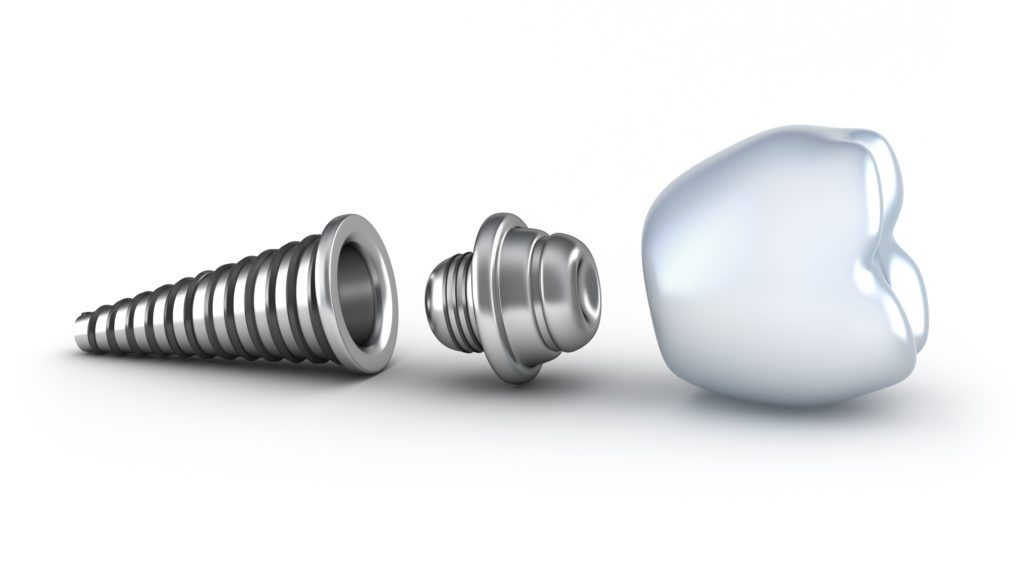Teeth are hard to live without. Even a few gaps in your arches can make it hard to eat, speak clearly, and smile. No matter how you lost yours, it is important to replace them. Fortunately, dental implants are the best treatment option available today. They are permanent, secure, and mimic natural teeth almost perfectly.
But how exactly to they work? Dr. Trinkner and Dr. Keefer are expert dental implant dentists in Columbia, SC. The following is a breakdown of what makes up a dental implant restoration and how they work.

Anatomy of a Dental Implant
Dental implants are a popular and effective way to permanently replace your missing teeth. To understand how they work, you need to be familiar with the anatomy of a dental implant. A dental implant consists of three parts: the implant fixture, the abutment, and the dental prosthetic.
The following explains each part and how they come together. We will provide you with the best replacement tooth option available at our dental office.
Implant Fixture
An implant fixture is the part that dentists use to secure a dental restoration and replace the missing tooth root. We also call it the dental implant post or implant body. The metal implant post looks like a screw because it has threads that hold it in place.
The fixture consists of titanium, a biocompatible material doctors often use for body prosthetics, or inner-body devices. Titanium will fuse with human bone tissue and create an ideal cellular response without issues. Implant fixtures come in many shapes and sizes to accommodate the various locations along the upper and lower jaw.
Your dentist or oral surgeon strategically places these fixture posts in the jaw bone to build the anchor for the replacement tooth. They will eventually fuse with the bone creating a sturdy base to hold your new teeth.
They will also stimulate the jaw bone to prevent bone loss. You will need one implant to replace one tooth. However, we can place two to eight implants depending on the amount of missing teeth that we are replacing.
The Abutment
The second part of a dental implant restoration is the abutment. The abutment acts as the connector piece between the implant post and the top restoration. They also consist of titanium, but will sit right above the gum line. In general, there are two types of post abutments, the healing abutment and the permanent abutment.
Permanent abutments come in many different styles and sizes to accommodate different types of dental prosthetics. Our dentist will secure an abutment to each dental implant after your mouth heals around them.
With a two-stage implant, our dentist connects the healing abutment after the implant fully fuses to your bone. Then, we let it heal for a few weeks before placing the final prosthetic.
With a one-stage implant, the healing abutment is already connected to the dental implant when we place it in your jaw. Then, we connect the permanent abutment to the dental implant only when the dental restoration is ready.
The Dental Prosthetic
The dental prosthetic is the last part we attach to complete the dental implant restoration. This is the part that acts as the crown portion of the tooth. The kind you need depends on how many teeth you are missing.
Today’s dental restorations blend in perfectly with your natural teeth. So naturally, we will make sure it matches your desired results. Dr. Trinkner or Dr. Keefer will help determine which restoration will work best for you. The three most common dental prosthetics that we can attach include the following:
- Dental Crown: A single dental crown is best when you are replacing one single lost tooth, or lost teeth that do not sit next to each other. The dental crown will consist of porcelain so that it looks as natural as possible. Our dentist will cap a single dental implant with a custom crown after the healing process.
- Dental Bridge: At least two dental implants and a dental bridge can replace consecutively missing teeth, or up to 5 row of missing teeth. The bridge will consist of two crowns that will attach to the dental implants, and the fake teeth or pontics that sit between the crowns.
- Denture: Anywhere from four to eight dental implants and a denture can replace the top or bottom arch of teeth. We offer both snap on dentures and permanent screw-in dentures to replace all of your teeth. Ask us about our implant-supported dentures.
Are you ready to replace your lost tooth or missing teeth using dental implants? Please call us at 803-400-8729 to request a dental implant consultation at our Columbia, SC, dental office. We serve St. Andrews, West Columbia, and all Lexington and Richland County. To learn more about our dental implant services, visit:
